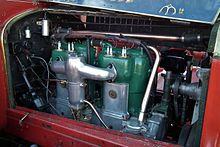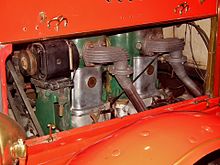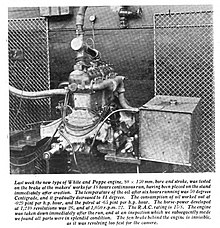| Company type | Private |
|---|---|
| Industry | petrol engines and other major automotive components |
| Founder | Alfred James White and Peter August Poppe |
| Fate | taken over by biggest customer in 1919, liquidated 1933 |
| Headquarters | Holbrook Lane, Coventry, United Kingdom |
| Area served | United Kingdom |
| Key people |
|
| Owner |
|
| Number of employees | 13,500 (1918) |
| Parent | Dennis Brothers Limited |


White and Poppe Limited was a proprietary engine building and gearbox manufacturing business established in Coventry in 1899 by Alfred James White (1870-) and Norwegian Peter August Poppe (1870-1933). Many early motor vehicle manufacturers bought in their major components so the company supplied up to 15 customers and employed around 350 people by 1914. Market changes reduced the customer-base but Dennis Brothers, always an important customer, took much of their output and purchased the company in 1919.
White and Poppe remained a distinct entity but during the Great Depression Dennis Brothers manufactured engines in their Surrey works and sourced diesel engines elsewhere. Thus the Coventry operation was disposed of by mid 1933.
Proprietors
This business was established in 1899 by Coventry-born Alfred James White (1870-) and Norwegian Peter August Poppe (1870-1933). They had met in Austria at a weapons factory where Poppe was on secondment from his job in Norway with Kongsberg weapons factory. White was the son of a retired watchmaker, supplier of chronometers to The Admiralty and director of White and Poppe customers Swift and Singer. White's family provided most of the capital for this new business and initially White looked after the accounts and called himself general manager. Poppe, an engineer, took charge of design and together they produced precision components for the automotive industry. Though Peter Poppe went to Rover in 1923 and a younger son left before the company closed its doors Alfred White and Poppe's eldest son Erling remained with the business until they had completed the transfer of operations to Guildford.
History
"High speed" petrol engines, carburettors, gearboxes, clutches . . .


White's partner, Peter August Poppe was designer and chief engineer. He and White and Poppe Limited jointly held many patents for inventions made by him.
Prior to World War I they served the booming motor industry with their engines in such high demand that at the 1906 British International Motor Exhibition 15 different firms displayed automobiles with White and Poppe engines.
By 1910 the White and Poppe carburettor was used by a large proportion of engine builders for motor boats, motorcars and aero engines. A variable jet provided a constant mixture. The petrol jet orifice and the air supply (throttle opening) were designed to cover the whole range of speeds.

The first Morris Oxford used a White and Poppe engine, carburettor, clutch and gearbox.
Dennis Brothers customers

W & P made high speed petrol engines for many motor manufacturers but most of their large engines were for Dennis Brothers Limited who became their largest customer. By the outbreak of war some kind of fusion of interests was being considered by the two boards.
Fuses, filling shells, aeroplane wings
During the war, in addition to the engines for Dennis Brothers and Hallford, by the end of the war some 4,000 of them, White and Poppe also made fuses. More specifically Fuse 80 bodies and 18pdr shell sockets, rings, caps and base plugs. White and Poppe also managed the Ministry of Munitions No.10 (later 21) National Shell Filling & Fuse factory, part of which was switched at the end of 1916 from fuses to making aeroplane wings. By November 1918 they employed 13,500 people.
Discussions resumed after the war and in April 1919 Dennis Brothers shareholders were asked to consent to the issue of new capital for Dennis Brothers to acquire W & P Later that year White and Poppe became a Dennis Brothers subsidiary but maintained its separate identity. The extent of the fuse-making business was such that there were severe difficulties in winding it up.
Dennis Brothers owners
Both Poppe and White were made directors of Dennis Brothers. In the recession of 1920 Poppe and another director were sent to USA to investigate their most modern manufacturing methods. At the end of 1921 the shareholders were told the Coventry factory had not been adequately employed and there was a search for new type of work away from motor transport.
As late as 1923, governments, British and foreign, continued to hold large war-surplus fleets of motor transport vehicles still dampening demand for Dennis commercial vehicles and demand for White & Poppe engines. The parent company developed a new multi stage turbine pump and turned to motor lawnmowers as well. By the end of 1923 the possibility of manufacture of London omnibuses had arisen. Poppe designed a new car but it was decided against putting it into production. He remained a director of Dennis Brothers until he resigned in 1923 though he continued the link as a consultant to Dennis Brothers. The Rover Company, their Clegg being obsolete, bought Peter Poppe and his completed car design making him their chief engineer and putting his car design into production as their Rover 14/45.

Alfred White remained in charge of the White and Poppe Coventry operation. By the end of 1924 the stock of war surplus commercial vehicles ceased to be a factor and the group's export sales were at an all-time record. The following year group profits trebled and the Guildford extensions paused in 1920 were resumed but the chairman made no other comment than confirming the wisdom of Dennis Brothers' purchase of White and Poppe. The extraordinary prosperity of Dennis Brothers' core business was demonstrated the next year when instead of issuing yet more bonus shares to shareholders they repaid £250,000 capital to their shareholders because the company held too much cash (£467,000 at balance date) for its own requirements. The White and Poppe operation was self-financing and managed to keep pace with the expansion at Guildford. A new engine was brought to market during 1926 and proved "an unqualified success . . . with large numbers of satisfied users". During the 1920s the rapid increase in turnover and profits was not due to increased prices but to higher sales volume. However White and Poppe's large factory was not yet at full capacity. Their principal product remained internal combustion engines.
Patented pivoted rocker gear
During 1929 new 6-cylinder engines were introduced. Experience had suggested operators would prefer the cheaper to buy and to maintain 4-cylinder engines. The new 6-cylinder engines were bending to the current fashion. A very valuable invention was patented which allowed the lifting of cylinder heads, decarbonising and valve grinding without dismantling the overhead camshaft. At the Annual General Meeting the chairman reported he had been asked to comment on the use of the crude oil engine and the chairman could "only assure him that we are fully alive to the possibilities".
Depression
A year later the chairman reported domestic sales remained constant but export sales had fallen considerably. A new six-cylinder Diesel engine had been designed and would shortly go under test. It would not be marketed until its performance equalled a petrol engine and to his knowledge no diesel engine did that at that time. Peter's son Erling Poppe (1898-1970) was now works manager at White and Poppe, Alfred White remained managing director.

By the end of 1931 "a number" of crude oil (Diesel) engines were out on test fitted to heavy goods vehicles. The following year group profits fell by 41 per cent though substantial reserves allowed the dividend to be maintained. The chairman announced that in view of the proliferation of new models and their shorter life over which to recover their design development and production costs together with the potential saving in transport costs it had been decided to gradually remove the manufacture of engines from Coventry to Guildford. A new building for the purpose was being completed in Guildford and the change would be complete within twelve months.
A few months later it was announced that Dennis would fit diesel engines made by Armstrong-Saurer Commercial Vehicles of Newcastle upon Tyne, Swiss Saurer products made under licence by Armstrong Whitworth. Dennis would have sole rights for the fitting of these products to passenger vehicles.
White and Poppe ceased operations on 28 March 1933. Required plant and machinery of a combined weight of more than 2000 tons was moved unpacked from Coventry to Guildford by road. Each machine was picked up from its old position and deposited in its new position at Guildford under the guidance of Erling Poppe at Guildford. This unpacked move of plant was reported as widely as possible because Dennis Brothers wanted it to be "a testimonial to the efficiency of road transport".
Liquidation
Dennis Brothers voluntarily liquidated White and Poppe, i.e. turned their assets into cash, on 28 March 1933. In the absence of any buyer they took ownership of the premises and eventually sold the Holbrook Lane Foleshill Coventry premises and plant and machinery not required in Guildford in May 1933. Much of the factory was taken over by SS Cars Ltd which later changed its name to Jaguar Cars Limited.
Some automobiles with White and Poppe engines

- Academy
- Arno
- Calcott
- Calthorpe
- Climax
- Clyde
- Globe
- Guy Motors
- Heron
- Horbick
Motorcycle engines
As well as a limited number of motorcycles under their own name, White and Poppe supplied engines to:
Commercial vehicle engines
See also
Notes
- J and E Hall of Dartford Automobile Engineering Works, Dartford, Kent
- a device in a bomb that controls the timing of the explosion
References
- Kimberley, Damien (2012). Coventry's Motorcar Heritage. Stroud: The History Press. ISBN 0752490419.
- ^ Beaven, Brad. The Growth and Significance of the Coventry Car Component Industry, 1895-1914.
- "The Olympia Motor Show". The Times. No. 39425. 9 November 1910. p. 17.
- "page 193". The Autocar. 6 August 1910.
- "White and Poppe Engines". The Autocar. 22 October 1910. p. 551.
- ^ "Company Meeting". The Times. No. 42080. 22 April 1919. p. 18.
- Batchelor, L.A. (2008). A Great munitions centre: Coventry's armaments and munitions industry 1914-1918. Unpublished MScR Thesis. Coventry: Coventry University
- ^ "Dennis Brothers (Limited)". The Times. No. 42266. 25 November 1919. p. 24.
- "Dennis Brothers, Limited". The Times. No. 42582. 1 December 1920. p. 21.
- "Dennis Brothers, Limited". The Times. No. 42891. 30 November 1921. p. 17.
- "Dennis Brothers". The Times. No. 43511. 29 November 1923. p. 18.
- "Dennis Brothers". The Times. No. 43822. 29 November 1924. p. 19.
- "City Notes". The Times. No. 43824. 2 December 1924. p. 22.
- "Dennis Brothers". The Times. No. 44132. 30 November 1925. p. 20.
- "City Notes". The Times. No. 44414. 28 October 1926. p. 18.
- "Dennis Brothers, Ltd". The Times. No. 44443. 1 December 1926. p. 23.
- "Dennis Brothers". The Times. No. 44753. 1 December 1927. p. 24.
- "Dennis Brothers, Limited". The Times. No. 45376. 3 December 1929. p. 21.
- "Dennis Brothers, Limited". The Times. No. 45685. 2 December 1930. p. 23.
- "Dennis Brothers, Limited". The Times. No. 45994. 1 December 1931. p. 21.
- "Dennis Brothers Limited". The Times. No. 46303. 29 November 1932. p. 20.
- "Passenger Vehicle Development". The Times. No. 46394. 16 March 1933. p. 8.
- "Dennis Brothers Limited". The Times. No. 46616. 1 December 1933. p. 23.
- Register of Defunct Companies, Stock Exchange Press, Macmillan, 1990 ISBN 9781349112739
- "Fuller, Horsey, Sons & Cassell". The Times. No. 46449. 20 May 1933. p. 22.
- ^ Jarman, L P; Barraclough, R I (1976). The Bullnose and Flatnose Morris. UK: David & Charles, Newton Abbott.
- "White and Poppe". Grace's Guide to British Industrial History. Retrieved 18 February 2017.
